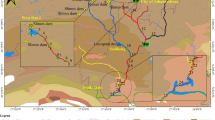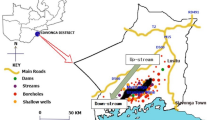Abstract
Following on Part I this paper explores possible health risks associated with mining-related uranium contamination of water using the case study of Potchefstroom, a municipality affected by deep level gold mining in the catchment of the Wonderfonteinspruit. Owing to the dolomitic nature of the water U peaks from upstream gold mining areas are likely to slip through the water treatment plant that relies on the standard potabilization process. The installation of an early warning monitoring system is proposed to stop abstraction if and when U peaks arrive.
Access this chapter
Tax calculation will be finalised at checkout
Purchases are for personal use only
Similar content being viewed by others
References
Albrecht C (2009): U concentration for tap water from Potchefstroom sampled April/May 2009. Cancer Research Association of South Africa (CANSA), unpublished.
Baeza, A, Salas, A, Legarda F (2008): Determining factors in the elimination of uranium and radium from groundwaters during standard potabilization process. Sci Tot Env, 406, 24–34.
Barthel R (2007): Assessment of the radiological impact of the mine water discharges to members of the public living around Wonderfonteinspruit catchment area. BSA-project-no. 0607-03, BS Associates, Consulting Engineers and Scientists, Report to the National Nuclear Regulator (NNR), Centurion, South Africa.
Busby C, Bertell R, Schmitz-Feuerhake I, Scott Cato M, Yablokov A (ed.) (2010): 2010 Recommendations of the European Committee on Radiation Risk. The health effects of exposure to low doses of ionizing radiation. Regulators’ edition. ISBN: 978-1-897761-16-8, Green Audit, Aberystwyth, United Kingdom, pp. 248.
DWAF (Department of Water affairs and Forestry) (2004): Mooi River surveillance. Uranium analyses for selected sites in the Mooi River catchment 1998–2004. unpublished.
Foodwatch e.V. (2008): Uranbelastung von Trinkwasser in Deutschland (Messung FAL-PB August bis November 2006, Stand 27.3.2008). Analytical results, 10 pp.
IWQS (Institute for Water Quality Studies) (1999): Report on the radioactivity monitoring programme in the Mooi River (Wonderfonteinspruit) catchment. Report No: N/C200/00/RPQ/2399. DWAF Pretoria, pp. 26, unpublished.
Nel B (2010): U concentration in weekly tap water samples of the Potchefstroom municipality, 2009–2010, unpublished.
Rosborg I, Nihlgard B, Gerhardson L, Gernersson ML, Ohlin R, OlssonT (2005): Concentrations of inorganic elements in bottled waters on the Swedish market. Environ Geochem Health, 27, 217–227.
Toens PD, Stadler W, Wullschlege NJ (1998): The association of groundwater chemistry and geology with atypical lymphocytes (as biological indicator) in the Poffadder area, North Western Cape, South Africa. WRC report 839/1/98.
Winde F (2010a): Uranium pollution of the Wonderfonteinspruit: 1997–2008. Part I: Utoxicity, regional background and mining-related sources of Upollution. Water SA, 36 (3), 239–256.
Winde F (2010b): Uranium pollution of the Wonderfonteinspruit: 1997 – 2008. Part II: U in water – concentrations, loads and associated risks. Water SA, 36 (3), 257–278.
Winde F, Erasmus E (2011): Peatlands as filters for polluted mine water? – A case study from an uranium-contaminated karst system in South Africa. Part I: Hydrogeological setting and Ufluxes. Water, 3, 291–322, doi:10.3390/w3010291.
Author information
Authors and Affiliations
Editor information
Editors and Affiliations
Rights and permissions
Copyright information
© 2011 Springer-Verlag Berlin Heidelberg
About this chapter
Cite this chapter
Winde, F. (2011). Challenges in Assessing Uranium-Related Health Risks: Two Case Studies for the Aquatic Exposure Pathway from South Africa – Part II: Case Study Potchefstroom. In: Merkel, B., Schipek, M. (eds) The New Uranium Mining Boom. Springer Geology. Springer, Berlin, Heidelberg. https://doi.org/10.1007/978-3-642-22122-4_62
Download citation
DOI: https://doi.org/10.1007/978-3-642-22122-4_62
Publisher Name: Springer, Berlin, Heidelberg
Print ISBN: 978-3-642-22121-7
Online ISBN: 978-3-642-22122-4
eBook Packages: Earth and Environmental ScienceEarth and Environmental Science (R0)




